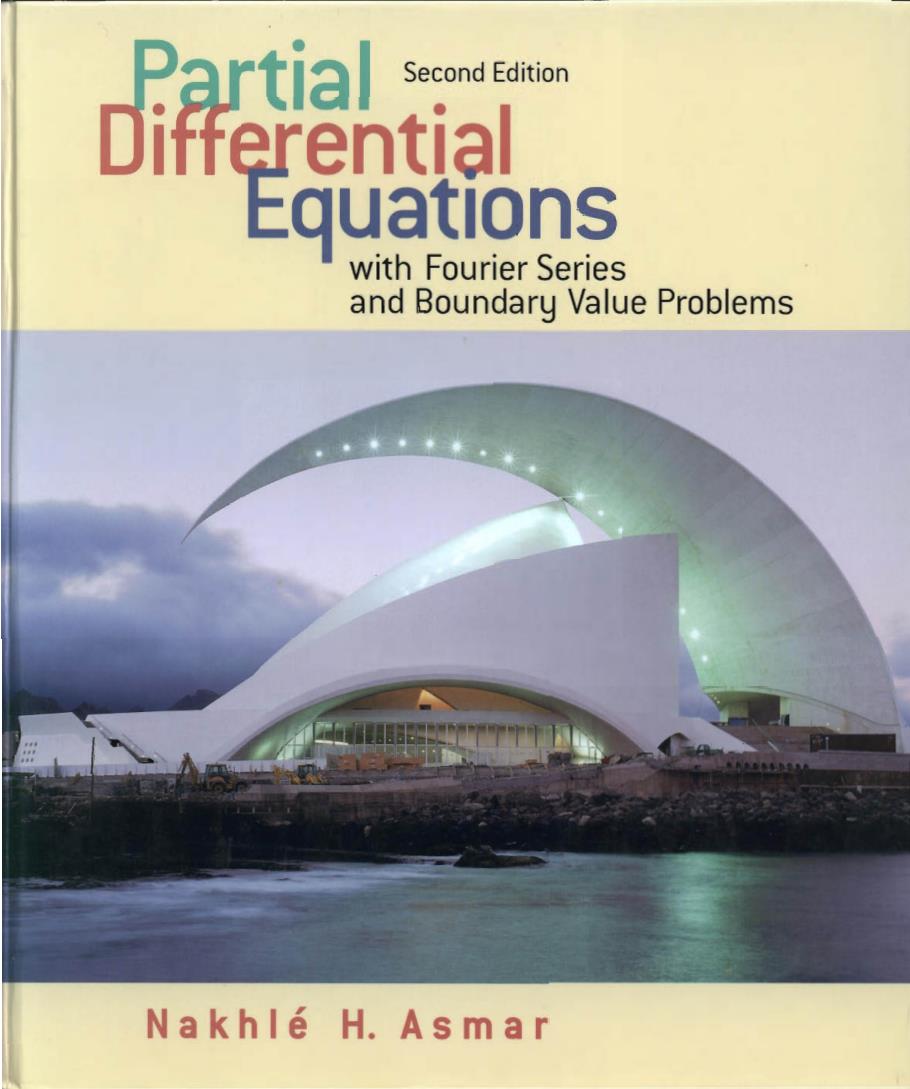
a Second Edition Equations with Fourier Series and Boundary Value Problems Nakhle H.Asmar
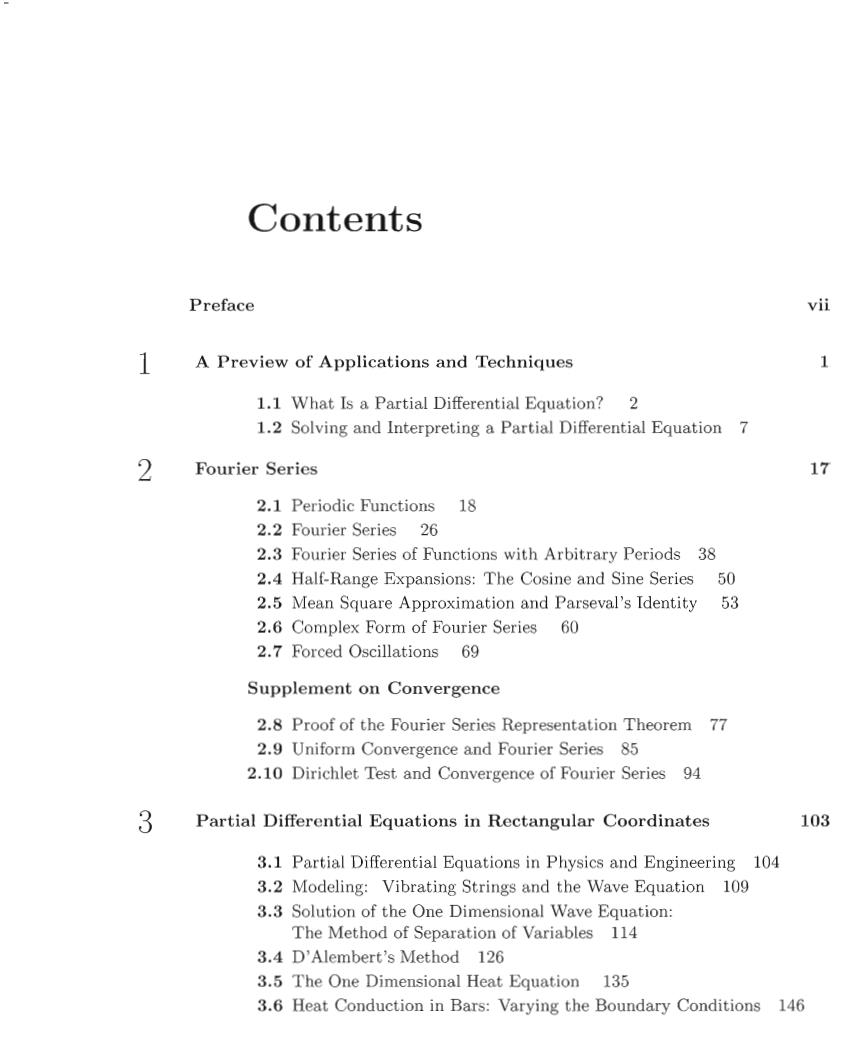
Contents Preface vii 1 A Preview of Applications and Techniques 1 1.1 What Is a Partial Differential Equation?2 1.2 Solving and Interpreting a Partial Differential Equation 7 2 Fourier Series 17 2.1 Periodic Functions 18 2.2 Fourier Series 26 2.3 Fourier Series of Functions with Arbitrary Periods 38 2.4 Half-Range Expansions:The Cosine and Sine Series 50 2.5 Mean Square Approximation and Parseval's Identity 53 2.6 Complex Form of Fourier Series 60 2.7 Forced Oscillations 69 Supplement on Convergence 2.8 Proof of the Fourier Series Representation Theorem 77 2.9 Uniform Convergence and Fourier Series 85 2.10 Dirichlet Test and Convergence of Fourier Series 94 3 Partial Differential Equations in Rectangular Coordinates 103 3.1 Partial Differential Equations in Physics and Engineering 104 3.2 Modeling:Vibrating Strings and the Wave Equation 109 3.3 Solution of the One Dimensional Wave Equation: The Method of Separation of Variables 114 3.4 D'Alembert's Method 126 3.5 The One Dimensional Heat Equation 135 3.6 Heat Conduction in Bars:Varying the Boundary Conditions 146
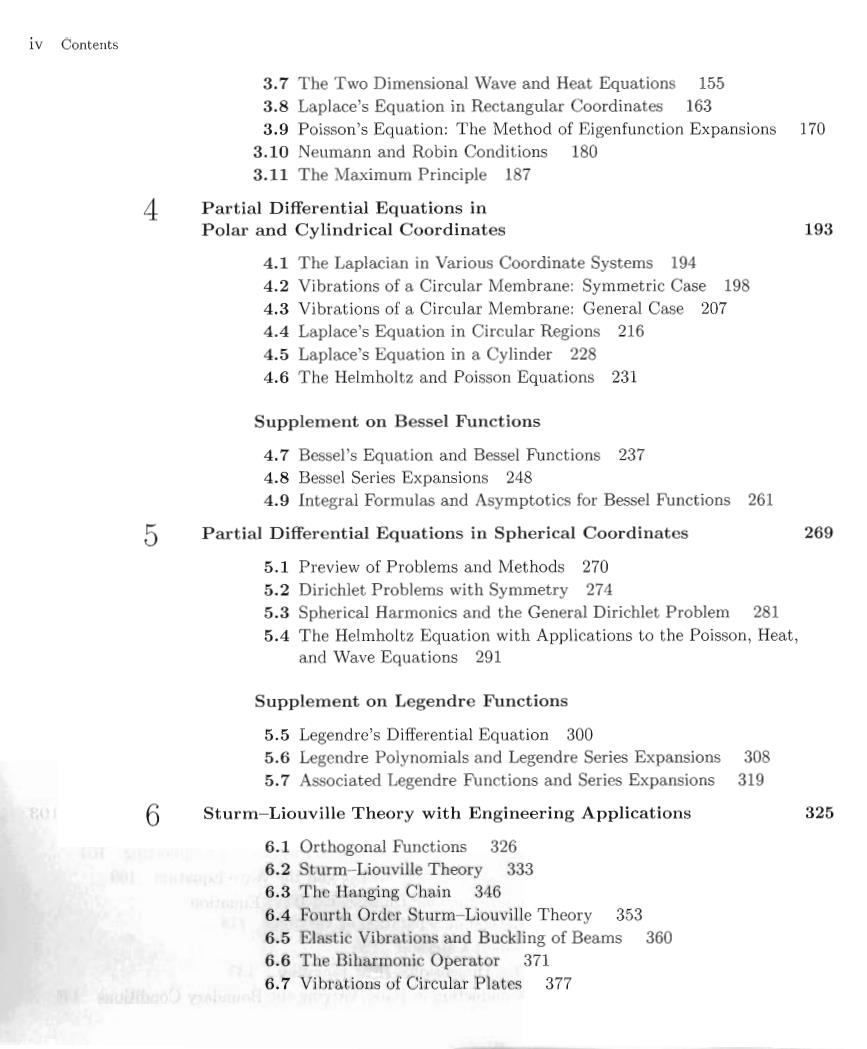
iv Contents 3.7 The Two Dimensional Wave and Heat Equations 155 3.8 Laplace's Equation in Rectangular Coordinates 163 3.9 Poisson's Equation:The Method of Eigenfunction Expansions 170 3.10 Neumann and Robin Conditions 180 3.11 The Maximum Principle 187 4 Partial Differential Equations in Polar and Cylindrical Coordinates 193 4.1 The Laplacian in Various Coordinate Systems 194 4.2 Vibrations of a Circular Membrane:Symmetric Case 198 4.3 Vibrations of a Circular Membrane:General Case 207 4.4 Laplace's Equation in Circular Regions 216 4.5 Laplace's Equation in a Cylinder 228 4.6 The Helmholtz and Poisson Equations 231 Supplement on Bessel Functions 4.7 Bessel's Equation and Bessel Functions 237 4.8 Bessel Series Expansions 248 4.9 Integral Formulas and Asymptotics for Bessel Functions 261 5 Partial Differential Equations in Spherical Coordinates 269 5.1 Preview of Problems and Methods 270 5.2 Dirichlet Problems with Symmetry 274 5.3 Spherical Harmonics and the General Dirichlet Problem 281 5.4 The Helmholtz Equation with Applications to the Poisson,Heat, and Wave Equations 291 Supplement on Legendre Functions 5.5 Legendre's Differential Equation 300 5.6 Legendre Polynomials and Legendre Series Expansions 308 5.7 Associated Legendre Functions and Series Expansions 319 801 6 Sturm-Liouville Theory with Engineering Applications 325 6.1 Orthogonal Functions 326 6.2 Sturm-Liouville Theory 333 6.3 The Hanging Chain 346 6.4 Fourth Order Sturm-Liouville Theory 353 6.5 Elastic Vibrations and Buckling of Beams 360 6.6 The Biharmonic Operator 371 6.7 Vibrations of Circular Plates 377 年hu0020s

Contents v 7 The Fourier Transform and Its Applications 389 7.1 The Fourier Integral Representation 390 7.2 The Fourier Transform 398 7.3 The Fourier Transform Method 411 7.4 The Heat Equation and Gauss's Kernel 420 7.5 A Dirichlet Problem and the Poisson Integral Formula 429 7.6 The Fourier Cosine and Sine Transforms 433 7.7 Problems Involving Semi-Infinite Intervals 440 7.8 Generalized Functions 445 7.9 The Nonhomogeneous Heat Equation 461 7.10 Duhamel's Principle 471 8 The Laplace and Hankel Transforms with Applications 479 8.1 The Laplace Transform 480 8.2 Further Properties of the Laplace Transform 491 8.3 The Laplace Transform Method 502 8.4 The Hankel Transform with Applications 508 9 Finite Difference Numerical Methods 515 9.1 The Finite Difference Method for the Heat Equation 516 9.2 The Finite Difference Method for the Wave Equation 525 9.3 The Finite Difference Method for Laplace's Equation 533 9.4 Iteration Methods for Laplace's Equation 541 10 Sampling and Discrete Fourier Analysis with Applications to Partial Differential Equations 546 10.1 The Sampling Theorem 547 10.2 Partial Differential Equations and the Sampling Theorem 555 10.3 The Discrete and Fast Fourier Transforms 559 10.4 The Fourier and Discrete Fourier Transforms 567 11 An Introduction to Quantum Mechanics 573 11.1 Schrodinger's Equation 574 11.2 The Hydrogen Atom 581 11.3 Heisenberg's Uncertainty Principle 590 Supplement on Orthogonal Polynomials 11.4 Hermite and Laguerre Polynomials 597
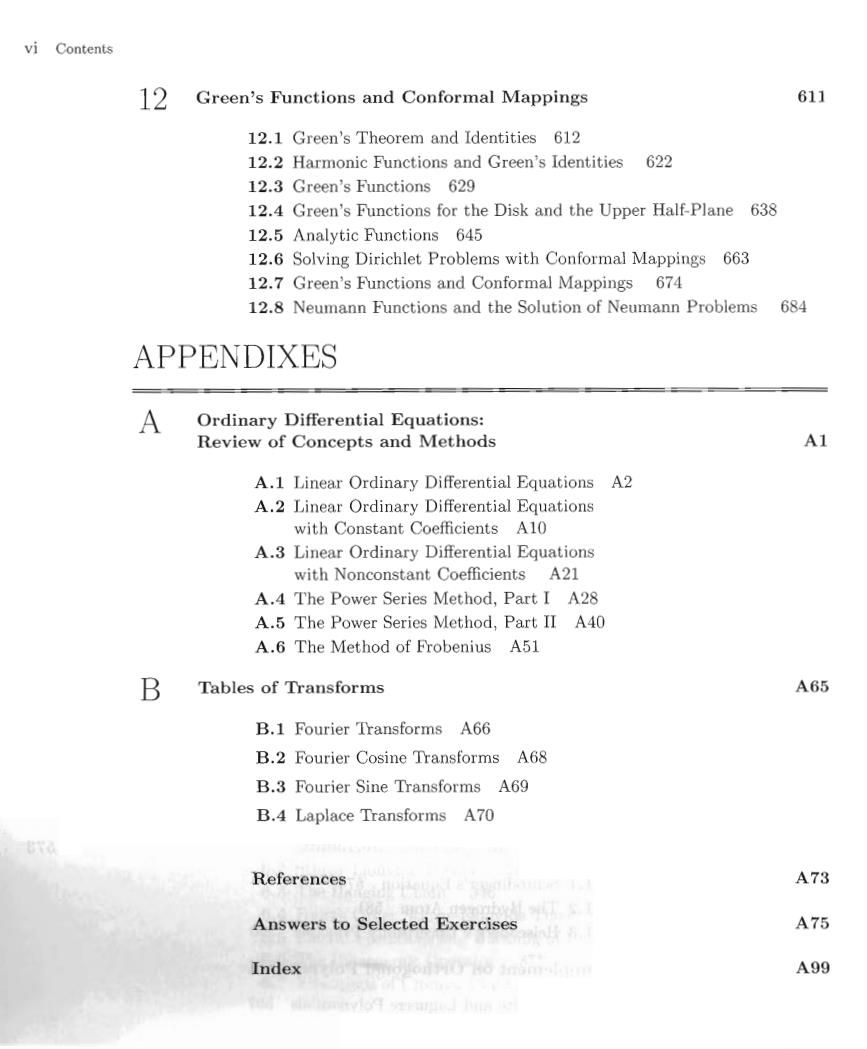
vi Contents 12 Green's Functions and Conformal Mappings 611 12.1 Green's Theorem and Identities 612 12.2 Harmonic Functions and Green's Identities 622 12.3 Green's Functions 629 12.4 Green's Functions for the Disk and the Upper Half-Plane 638 12.5 Analytic Functions 645 12.6 Solving Dirichlet Problems with Conformal Mappings 663 12.7 Green's Functions and Conformal Mappings 674 12.8 Neumann Functions and the Solution of Neumann Problems 684 APPENDIXES A Ordinary Differential Equations: Review of Concepts and Methods A1 A.1 Linear Ordinary Differential Equations A2 A.2 Linear Ordinary Differential Equations with Constant Coefficients A10 A.3 Linear Ordinary Differential Equations with Nonconstant Coefficients A21 A.4 The Power Series Method,Part I A28 A.5 The Power Series Method,Part II A40 A.6 The Method of Frobenius A51 B Tables of Transforms A65 B.1 Fourier Transforms A66 B.2 Fourier Cosine Transforms A68 B.3 Fourier Sine Transforms A69 B.4 Laplace Transforms A70 Era References A73 Answers to Selected Exercises A75 Index o nom....m A99 po年生
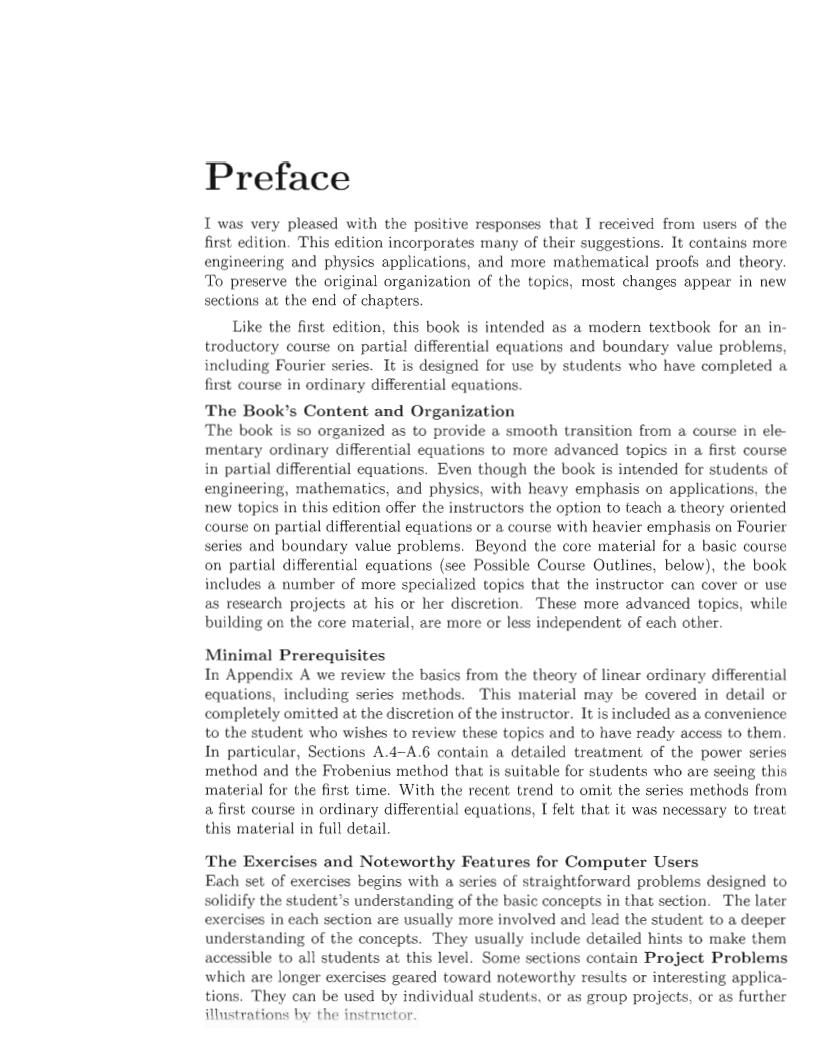
Preface I was very pleased with the positive responses that I received from users of the first edition.This edition incorporates many of their suggestions.It contains more engineering and physics applications,and more mathematical proofs and theory. To preserve the original organization of the topics,most changes appear in new sections at the end of chapters. Like the first edition,this book is intended as a modern textbook for an in- troductory course on partial differential equations and boundary value problems, including Fourier series.It is designed for use by students who have completed a first course in ordinary differential equations. The Book's Content and Organization The book is so organized as to provide a smooth transition from a course in ele- mentary ordinary differential equations to more advanced topics in a first course in partial differential equations.Even though the book is intended for students of engineering,mathematics,and physics,with heavy emphasis on applications,the new topics in this edition offer the instructors the option to teach a theory oriented course on partial differential equations or a course with heavier emphasis on Fourier series and boundary value problems.Beyond the core material for a basic course on partial differential equations (see Possible Course Outlines,below),the book includes a number of more specialized topics that the instructor can cover or use as research projects at his or her discretion.These more advanced topics,while building on the core material,are more or less independent of each other. Minimal Prerequisites In Appendix A we review the basics from the theory of linear ordinary differential equations,including series methods.This material may be covered in detail or completely omitted at the discretion of the instructor.It is included as a convenience to the student who wishes to review these topics and to have ready access to them. In particular,Sections A.4-A.6 contain a detailed treatment of the power series method and the Frobenius method that is suitable for students who are seeing this material for the first time.With the recent trend to omit the series methods from a first course in ordinary differential equations,I felt that it was necessary to treat this material in full detail The Exercises and Noteworthy Features for Computer Users Each set of exercises begins with a series of straightforward problems designed to solidify the student's understanding of the basic concepts in that section.The later exercises in each section are usually more involved and lead the student to a deeper understanding of the concepts.They usually include detailed hints to make them accessible to all students at this level.Some sections contain Project Problems which are longer exercises geared toward noteworthy results or interesting applica- tions.They can be used by individual students.or as group projects,or as further illustrations by the instructor
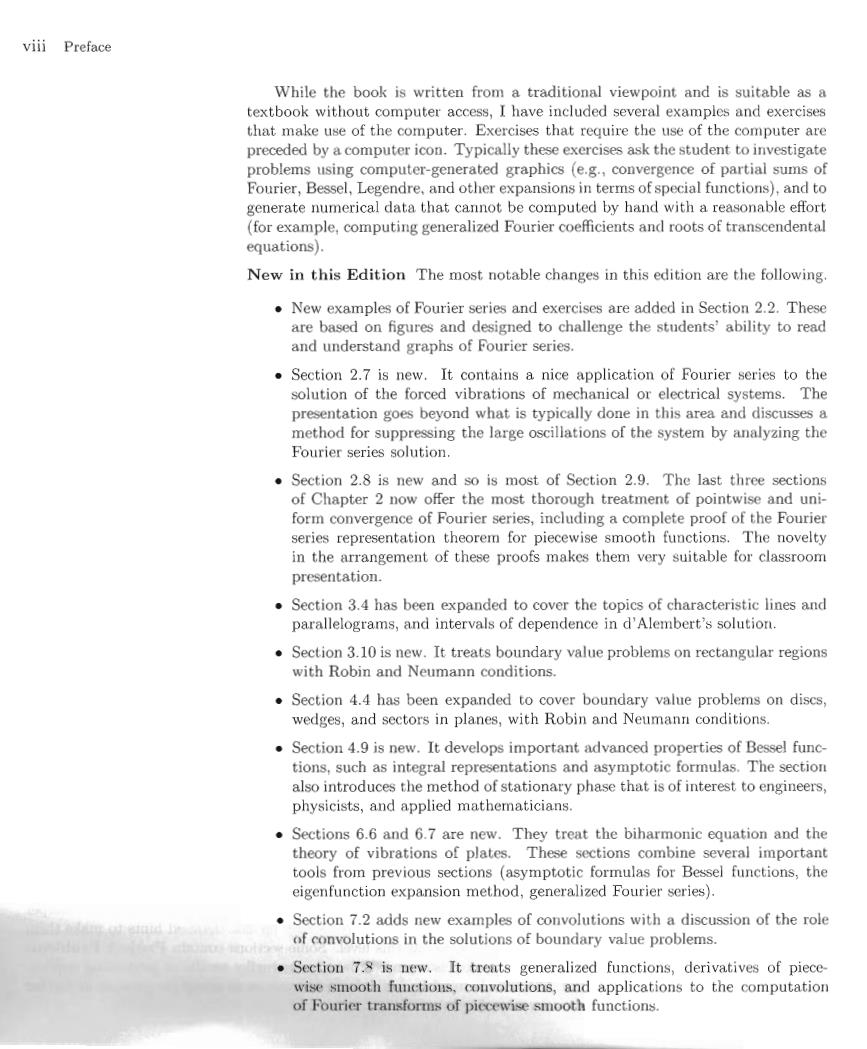
viii Preface While the book is written from a traditional viewpoint and is suitable as a textbook without computer access,I have included several examples and exercises that make use of the computer.Exercises that require the use of the computer are preceded by a computer icon.Typically these exercises ask the student to investigate problems using computer-generated graphics (e.g.,convergence of partial sums of Fourier,Bessel,Legendre,and other expansions in terms of special functions),and to generate numerical data that cannot be computed by hand with a reasonable effort (for example,computing generalized Fourier coefficients and roots of transcendental equations). New in this Edition The most notable changes in this edition are the following New examples of Fourier series and exercises are added in Section 2.2.These are based on figures and designed to challenge the students'ability to read and understand graphs of Fourier series. Section 2.7 is new.It contains a nice application of Fourier series to the solution of the forced vibrations of mechanical or electrical systems.The presentation goes beyond what is typically done in this area and discusses a method for suppressing the large oscillations of the system by analyzing the Fourier series solution. .Section 2.8 is new and so is most of Section 2.9.The last three sections of Chapter 2 now offer the most thorough treatment of pointwise and uni- form convergence of Fourier series,including a complete proof of the Fourier series representation theorem for piecewise smooth functions.The novelty in the arrangement of these proofs makes them very suitable for classroom presentation. Section 3.4 has been expanded to cover the topics of characteristic lines and parallelograms,and intervals of dependence in d'Alembert's solution. Section 3.10 is new.It treats boundary value problems on rectangular regions with Robin and Neumann conditions. Section 4.4 has been expanded to cover boundary value problems on discs, wedges,and sectors in planes,with Robin and Neumann conditions. Section 4.9 is new.It develops important advanced properties of Bessel func- tions,such as integral representations and asymptotic formulas.The section also introduces the method of stationary phase that is of interest to engineers, physicists,and applied mathematicians. Sections 6.6 and 6.7 are new.They treat the biharmonic equation and the theory of vibrations of plates.These sections combine several important tools from previous sections (asymptotic formulas for Bessel functions,the eigenfunction expansion method,generalized Fourier series). .Section 7.2 adds new examples of convolutions with a discussion of the role of convolutions in the solutions of boundary value problems. Section 7.8 is new.It treats generalized functions,derivatives of piece- wise smooth functions,convolutions,and applications to the computation of Fourier transforms of piecewise smooth functions
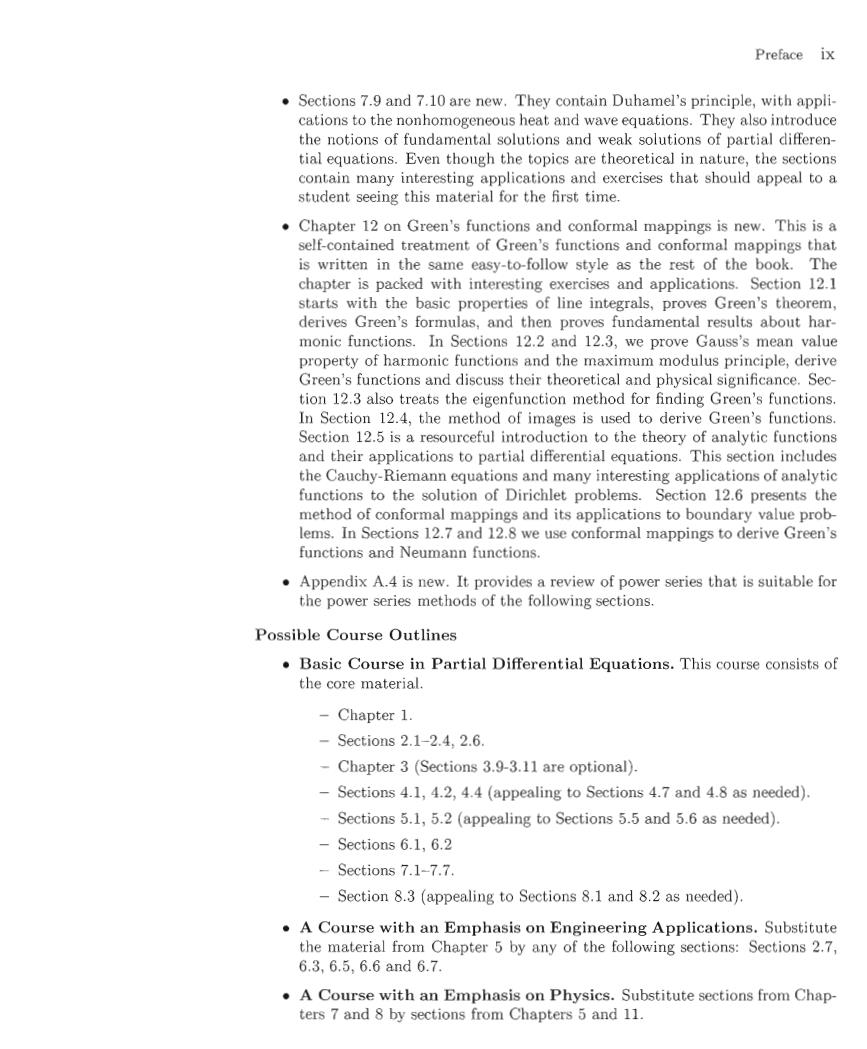
Preface ix Sections 7.9 and 7.10 are new.They contain Duhamel's principle,with appli- cations to the nonhomogeneous heat and wave equations.They also introduce the notions of fundamental solutions and weak solutions of partial differen- tial equations.Even though the topics are theoretical in nature,the sections contain many interesting applications and exercises that should appeal to a student seeing this material for the first time. Chapter 12 on Green's functions and conformal mappings is new.This is a self-contained treatment of Green's functions and conformal mappings that is written in the same easy-to-follow style as the rest of the book.The chapter is packed with interesting exercises and applications.Section 12.1 starts with the basic properties of line integrals,proves Green's theorem, derives Green's formulas,and then proves fundamental results about har- monic functions.In Sections 12.2 and 12.3,we prove Gauss's mean value property of harmonic functions and the maximum modulus principle,derive Green's functions and discuss their theoretical and physical significance.Sec- tion 12.3 also treats the eigenfunction method for finding Green's functions. In Section 12.4,the method of images is used to derive Green's functions. Section 12.5 is a resourceful introduction to the theory of analytic functions and their applications to partial differential equations.This section includes the Cauchy-Riemann equations and many interesting applications of analytic functions to the solution of Dirichlet problems.Section 12.6 presents the method of conformal mappings and its applications to boundary value prob- lems.In Sections 12.7 and 12.8 we use conformal mappings to derive Green's functions and Neumann functions. .Appendix A.4 is new.It provides a review of power series that is suitable for the power series methods of the following sections. Possible Course Outlines Basic Course in Partial Differential Equations.This course consists of the core material. Chapter 1. -ections2.1-2.4.2.6 Chapter 3(Sections 3.9-3.11 are optional). -Sections 4.1,4.2,4.4 (appealing to Sections 4.7 and 4.8 as needed) -Sections 5.1,5.2 (appealing to Sections 5.5 and 5.6 as needed). Sections 6.1,6.2 一 Sections 7.1-7.7. Section 8.3 (appealing to Sections 8.1 and 8.2 as needed) A Course with an Emphasis on Engineering Applications.Substitute the material from Chapter 5 by any of the following sections:Sections 2.7, 6.3,6.5,6.6and6.7. A Course with an Emphasis on Physics.Substitute sections from Chap- ters 7 and 8 by sections from Chapters 5 and 11
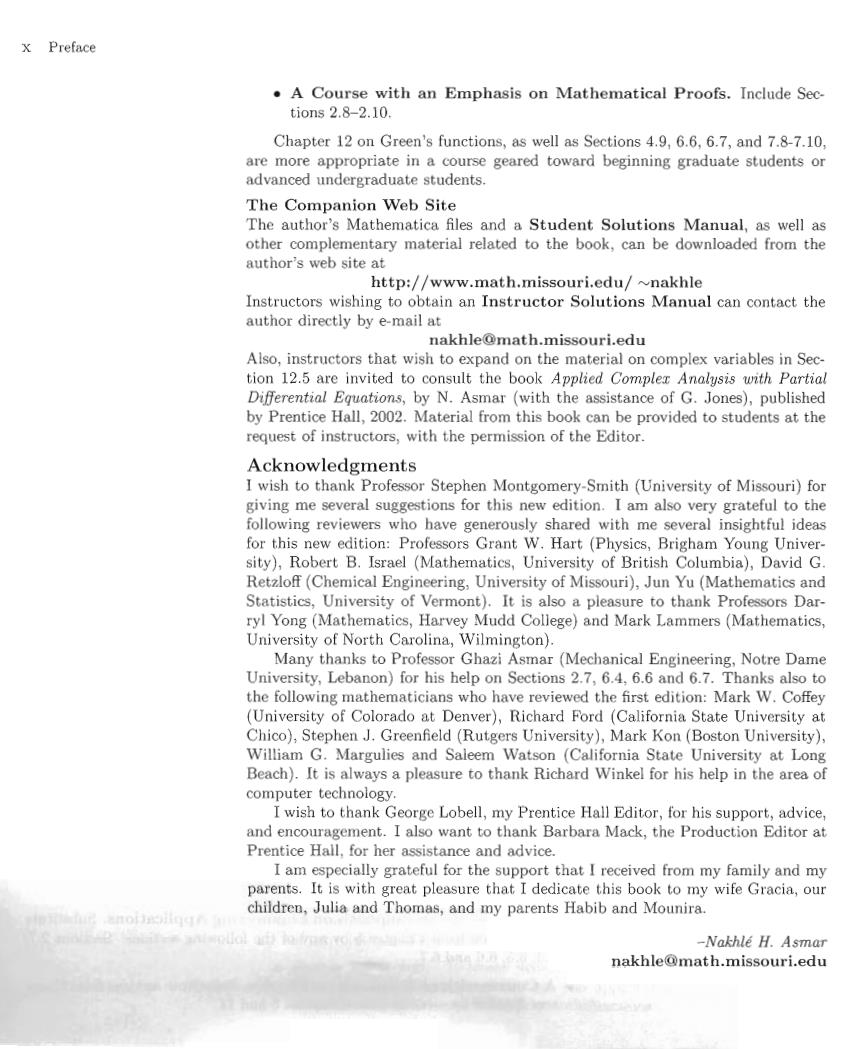
x Preface A Course with an Emphasis on Mathematical Proofs.Include Sec. tions2.8-2.10 Chapter 12 on Green's functions,as well as Sections 4.9,6.6,6.7,and 7.8-7.10, are more appropriate in a course geared toward beginning graduate students or advanced undergraduate students. The Companion Web Site The author's Mathematica files and a Student Solutions Manual,as well as other complementary material related to the book,can be downloaded from the author's web site at http://www.math.missouri.edu/~nakhle Instructors wishing to obtain an Instructor Solutions Manual can contact the author directly by e-mail at nakhle@math.missouri.edu Also,instructors that wish to expand on the material on complex variables in Sec- tion 12.5 are invited to consult the book Applied Complex Analysis with Partial Differential Equations,by N.Asmar (with the assistance of G.Jones),published by Prentice Hall,2002.Material from this book can be provided to students at the request of instructors,with the permission of the Editor. Acknowledgments I wish to thank Professor Stephen Montgomery-Smith (University of Missouri)for giving me several suggestions for this new edition.I am also very grateful to the following reviewers who have generously shared with me several insightful ideas for this new edition:Professors Grant W.Hart (Physics,Brigham Young Univer- sity),Robert B.Israel (Mathematics,University of British Columbia),David G. Retzloff(Chemical Engineering,University of Missouri),Jun Yu (Mathematics and Statistics,University of Vermont).It is also a pleasure to thank Professors Dar- ryl Yong(Mathematics,Harvey Mudd College)and Mark Lammers (Mathematics University of North Carolina,Wilmington). Many thanks to Professor Ghazi Asmar(Mechanical Engineering,Notre Dame University,Lebanon)for his help on Sections 2.7,6.4,6.6 and 6.7.Thanks also to the following mathematicians who have reviewed the first edition:Mark W.Coffey (University of Colorado at Denver),Richard Ford (California State University at Chico),Stephen J.Greenfield(Rutgers University),Mark Kon(Boston University), William G.Margulies and Saleem Watson (California State University at Long Beach).It is always a pleasure to thank Richard Winkel for his help in the area of computer technology. I wish to thank George Lobell,my Prentice Hall Editor,for his support,advice, and encouragement.I also want to thank Barbara Mack,the Production Editor at Prentice Hall,for her assistance and advice. I am especially grateful for the support that I received from my family and my parents.It is with great pleasure that I dedicate this book to my wife Gracia,our children,Julia and Thomas,and my parents Habib and Mounira. -Nakhle H.Asmar nakhle@math.missouri.edu

1 Topics to Review This chapter is self-contained and requires basic knowledge from A PREVIEW calenlus,such as partial deriva- tives.We make occasional refer- OF APPLICATIONS ences to topics from a first course in ordinary differential equations. AND TECHNIQUES These topics are found in Ap- pendix A and can be called on as needed. Looking Ahead... Everything should be made as simple as possible,but no simpler This chapter is intended to intro- -ALBERT EINSTEIN duce some of the basic notions occurring in the study of partial differential equations and bound- ary value problems.Section 1.1 introduces the notion of a par- tial differential equation and of fers some clementary but useful solution techniques.Section 1.2 focuses primarily on the develop- Partial differential equations arise in modeling numerous phenomena in sci- ment of a simple but central ex- ence and engineering.In this chapter we preview the ideas and techniques ample in partial differential equa- that will be studied in this book.Our goal is to convey something of the fa- tions,the vibrating string.The vor of partial differential equations and their use in applications rather than reader is taken to a point where to give a systematic development.In particular,by focusing on the vibration several of the major landmarks of of a stretched string,we will see how partial differential equations arise in the field may be surveyed.This modeling a physical phenomenon and how the interpretation of their solu- preview shows clearly the need tions helps us to understand this phenomenon.The chapter will culminate for the treatment of Fourier se- with a brief discussion of Fourier series that highlights their importance to ries of Chapter 2 and the other the development of the applications of partial differential equations. more systematic developments to follow